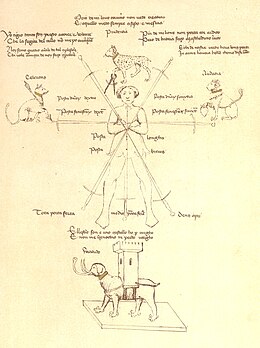This article includes a list of references, related reading, or external links, but its sources remain unclear because it lacks inline citations. (January 2024) |
The Flos Duellatorum is the name given to one of the manuscript versions of Fiore dei Liberi's illuminated manuscript fight book, written in 1410 (dated to 1409 in the old reckoning). There are five other surviving recensions, under the title Fior di Battaglia. Both Flos Duellatorum and Fior di Battaglia translate into English roughly as "The Flower of Battle," from Latin and Italian respectively.

Manuscripts
editThe manuscript dated to 1409 was considered lost, and is now known to be kept in a private collection. It is referred to as the Pisani-Dossi manuscript for the last collection it was a part of before its disappearance. The information contained within survives in the form of a 1902 facsimile by the Italian historian Francesco Novati. Because of this, the Flos Duellatorum is also known as the Novati Manuscript, or the Novati Edition.
The other two surviving manuscripts are the Getty-Ludwig ("Getty's copy", Los Angeles, MS Ludwig XV13) and the Pierpont Morgan Library ("Morgan's copy", New York, MS M 0.0383) copies. Both of these bear the title Fior di Battaglia, and both are undated.
The Morgan copy unlike the other two versions does not contain a dedication to Nicolò III d'Este, in whose service Fiore composed his treatise. Its prologue is similar to the Getty version.
The Getty-Ludwig version is the most informative, being distinguished by several categorizations added by its copyist and, according to Robert Charron, an expert on the manuscript, by the degree of comprehension of the master's teaching displayed.
Inventories of the Estense library in Ferrara indicate that there were at least five copies of Fiore's work. By 1508, the manuscripts cease to be mentioned in the inventories. Two versions of Fiore's manuscript re-surfaced in private collections in Venice. The Morgan and Getty versions both were kept in England during the 19th century, before being moved to their present locations in America in the 20th century.
Contents
editThe Novati consists of illustrated pictures of the plays accompanied by short, rhyming verses in Italian to describe them.
The Pisani-Dossi version contains major sections on:
- Wrestling
- Dagger play (including defenses against a dagger when armed with a dagger and without one)
- Sword in one hand
- Spear and staff (The weapons are treated identically in Fiore's system)
- Sword in two hands
- Sword in armour (Chiefly halfswording techniques)
- Poleaxe
- Mounted combat (including wrestling, swordplay, and the lance from horseback)
- Sword vs. Dagger
Fiore also mentions the use of:
- Bastoncello (The baton)
- Staff and dagger
- Pairs of clubs or cudgels
- The use of the chiavarina (spear) against a man on horseback
Sette spade
editThe best-known image from the Flos Duellatorum is the sette spade (seven swords) diagram at the beginning of the longsword section (fol. 17A), reminiscent of the first image of the Codex Wallerstein. It is a figure of a man, divided by seven swords centered on the body, representing the poste or guard positions. This is surrounded by four animals, representing the main virtues of a fencer:
- On top, the lynx holding a compass represents prudentia:
- Meio de mi'louo ceruino non uede creatura / E aquello meto sempre a sesto e mesura.
- "No other creature is able to look so clearly as me, the lynx / and by this I ever reckon by compass and measure"
- To the left, the tiger holding an arrow represents celeritas
- Yo tigro tanto son presto a corer e uoltare / Che la sagita del cello non me po auancare.
- "I am the tiger, I am very quick to run and turn / That the arrow in the sky cannot approach me."
- To the right, the lion holding a heart represents audatia
- Piu de mi lione non porta cor ardito / Pero de bataia faço a zaschaduno inuito.
- "None bears a more ardent heart than me, a lion / And I challenge anyone to battle."
- On the bottom, the elephant carrying a tower represents fortitudo:
- Ellefant son e uno castello ho per cargho / E non me inçenochio ni perdo uargho.
- "I am the elephant and I have a castle for a burden / And never do I kneel down nor do I lose my true place."
See also
editExternal links
edit- Novati facsimile of the Pisani-Dossi MS (PDF file, 42M)
- " The Flower of Battle" (Getty's copy)
- Fior Di Battaglia Translation and Interpretation Project (text and translation)
- AEMMA Flos Duellatorum material
- Sala d'Arme Achille Marozzo (Italian Ancient Fencing Art Institute) transcriptions (Getty, Morgan and Pisani-Dossi) Archived 2007-03-14 at the Wayback Machine
- Fiore Dei Liberi: 14th century Master of Defence by John Clements (ARMA)
- http://www.getty.edu/art/collection/objects/1443/unknown-fiore-furlan-dei-liberi-da-premariacco-il-fior-di-battaglia-italian-about-1410/ - Versione digitale del manoscritto al P. Getty Museum
Further reading
edit- Flos Duellatorum - Manuale di Arte del Combattimento del XV secolo di Fiore dei Liberi, Italian Publication by Marco Rubboli and Luca Cesari, Il Cerchio - Gli Archi, ISBN 88-8474-023-1